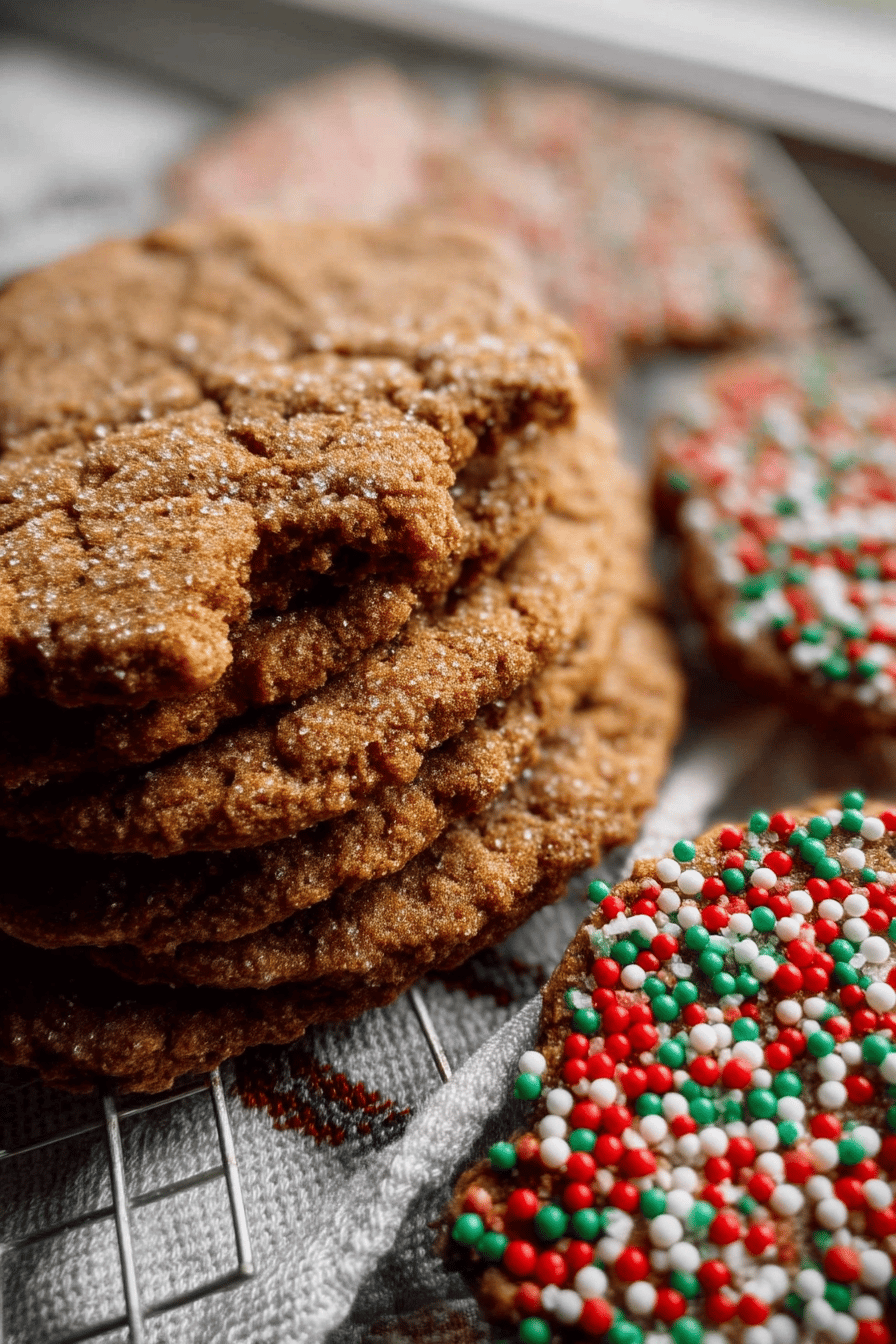Benefits and Advantages of Gingerbread Cookies
Gingerbread cookies are beloved for their delightful flavor and versatile nature. This particular recipe stands out due to its ease of preparation, making it accessible for both novice and experienced bakers. Utilizing simple steps and common ingredients, it allows for a quick yet satisfying baking experience that fits well into busy schedules.
The warm and aromatic spices in gingerbread cookies, such as ginger and cinnamon, provide not only a rich taste but also potential health benefits. These spices are known for their anti-inflammatory and digestive properties, which can aid in soothing upset stomachs and improving circulation.
Incorporating spices like ginger and cinnamon enhances flavor and adds a nutritious element to your treats.
Another advantage is the adaptability of this recipe. It can be easily tailored to suit various dietary needs including vegan and gluten-free alternatives, increasing its appeal among health-conscious bakers. The balanced combination of sweetness from molasses and sugar with the warm spices creates cookies that are perfect for festive occasions or everyday enjoyment.
- Quick and easy to make with minimal steps
- Spices offer anti-inflammatory and digestive benefits
- Customizable for different diets such as vegan and gluten-free
- Ideal for both special occasions and daily treats
For those interested in holiday baking ideas, these gingerbread cookies complement other festive recipes you can find on my blog, such as Christmas Hot Pepper Jelly.
Essential Ingredients for Gingerbread Cookies
The foundation of delicious gingerbread cookies lies in selecting the right ingredients. Below is a comprehensive list of items required to create soft, flavorful cookies that capture the traditional taste:
- ¾ cup (170 g) unsalted butter, softened
- 1 cup (200 g) granulated sugar (or substitute with ¾ cup (150 g) packed brown sugar for richer flavor)
- 1 large egg
- ¼ cup (80 ml) unsulphured molasses (dark molasses preferred; avoid blackstrap or black treacle to prevent bitterness)
- 2 ½ cups (312 g) all-purpose flour (stir, spoon into measuring cup, and level for accuracy)
- 2 teaspoons baking soda
- ½ teaspoon salt
- 1 to 2 teaspoons ground cinnamon (adjust to taste)
- ½ to 2 teaspoons ground ginger (adjust to taste)
- Optional spices: ½ teaspoon ground cloves, ½ teaspoon ground allspice, nutmeg, mace, or white pepper for added complexity
- Optional: granulated sugar for rolling cookie dough balls
| Ingredient | Quantity | Purpose |
|---|---|---|
| Unsalted butter | ¾ cup (170 g) | Provides fat for texture and flavor |
| Granulated sugar / Brown sugar | 1 cup (200 g) / ¾ cup (150 g) | Adds sweetness and moisture |
| Egg | 1 large | Binds ingredients and adds structure |
| Unsulphured molasses | ¼ cup (80 ml) | Gives rich color and distinctive flavor |
| All-purpose flour | 2 ½ cups (312 g) | Forms the cookie base |
| Baking soda | 2 teaspoons | Leavening agent to help cookies rise |
| Salt | ½ teaspoon | Enhances flavor balance |
| Ground cinnamon | 1 to 2 teaspoons | Provides warm spice note |
| Ground ginger | ½ to 2 teaspoons | Adds signature spicy kick |
These ingredients work together to deliver the ideal chewy yet slightly crisp texture and the classic spicy-sweet taste that gingerbread cookies are known for. Measuring flour correctly by stirring and leveling the cup or weighing it ensures the best consistency.
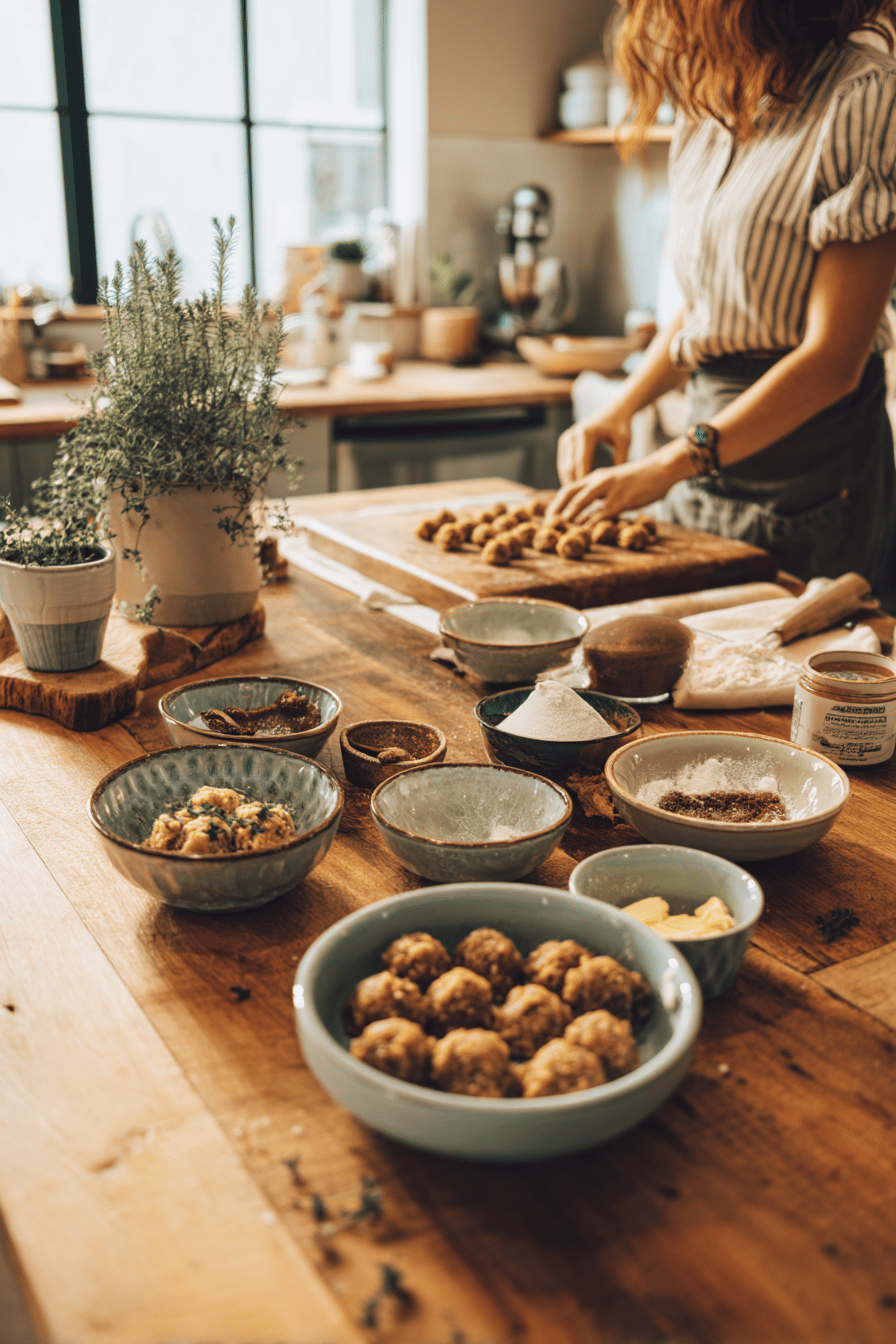
Dietary Substitutions to Customize Your Gingerbread Cookies
Whether you’re baking for dietary restrictions or personal preferences, gingerbread cookies offer flexible options with simple ingredient swaps. These substitutions maintain the signature flavor and texture of the cookies without compromising quality.
Vegan Alternatives
- Butter: Replace unsalted butter with coconut oil or vegan margarine.
- Egg: Use a flaxseed or chia seed egg (1 tablespoon ground flaxseed/chia seed mixed with 3 tablespoons water, allowed to gel) as a binder.
- Molasses: Standard unsulphured molasses remains suitable for vegan diets.
Gluten-Free Options
- Swap all-purpose flour for a gluten-free all-purpose blend containing xanthan gum to replicate dough elasticity.
- Ensure all other ingredients are certified gluten-free to prevent cross-contamination.
Sugar and Sweetener Alternatives
- Reduce calories by substituting sugar with erythritol, stevia blends, or monk fruit sweeteners.
- Note that these replacements may slightly alter texture and browning properties.
Allergy-Friendly Adjustments
- Omit optional nut-based extracts or toppings if allergies are a concern.
- Use alternative flavorings like vanilla extract to enhance taste safely.
Simple swaps can tailor gingerbread cookies to fit many dietary needs while preserving the cozy flavors you love.
Experimenting with these alternatives allows everyone to enjoy homemade gingerbread cookies regardless of dietary restrictions. For more inclusive dessert options, explore recipes like gingerbread cheesecake cookies that offer a unique twist.
How to Prepare the Perfect Gingerbread Cookies: Step-by-Step Guide
Creating the perfect gingerbread cookies is an enjoyable process that anyone can master with a few guided steps. Below is a detailed, easy-to-follow method to bake soft and chewy gingerbread cookies with a slight crunch on the outside. This guide also highlights flexibility for personal preferences in spices and dough handling.
Ingredients Preparation
- ¾ cup (170 g) unsalted butter, softened
- 1 cup (200 g) granulated sugar (or substitute with ¾ cup (150 g) packed brown sugar for richer flavor)
- 1 large egg
- ¼ cup (80 ml) unsulphured molasses (prefer dark molasses; avoid blackstrap or black treacle to prevent bitterness)
- 2 ½ cups (312 g) all-purpose flour (measure by stirring, spooning into cup and leveling)
- 2 teaspoons baking soda
- ½ teaspoon salt
- 1 to 2 teaspoons ground cinnamon (adjust to taste)
- ½ to 2 teaspoons ground ginger (adjust to taste)
- Optional: ½ teaspoon ground cloves, ½ teaspoon ground allspice, nutmeg, mace, or white pepper for extra spice complexity
- Optional: granulated sugar for rolling dough balls
Step-By-Step Baking Instructions
- Preheat your oven to 350°F (175°C) for an even, consistent bake.
- Using an electric mixer, beat the softened butter and sugar together in a large bowl for 2-3 minutes until light and fluffy.
- Add the egg and molasses to the butter-sugar mixture and blend thoroughly until combined.
- In a separate bowl, whisk together all dry ingredients: flour, baking soda, salt, cinnamon, ginger, and any additional chosen spices.
- Gradually incorporate the dry ingredients into the wet ingredients, mixing gently until a soft dough forms.
- If desired, form dough into balls slightly smaller than golf balls and optionally roll each in granulated sugar to create a delightful crunch.
- Place dough balls 2 to 3 inches apart on an ungreased or parchment-lined baking sheet, ensuring enough room to prevent sticking.
- Bake in the preheated oven for 10 to 12 minutes, until cookie edges are firm but centers remain soft.
- Let cookies cool on the baking sheet for about 10 minutes before transferring to a wire rack to cool completely.
Note: This recipe does not require chilling the dough unless you are rolling and cutting shapes, which benefits from refrigeration to maintain form.
For home cooks looking for related sweet treats, explore the gingerbread cheesecake cookies recipe for a delightful holiday variation.
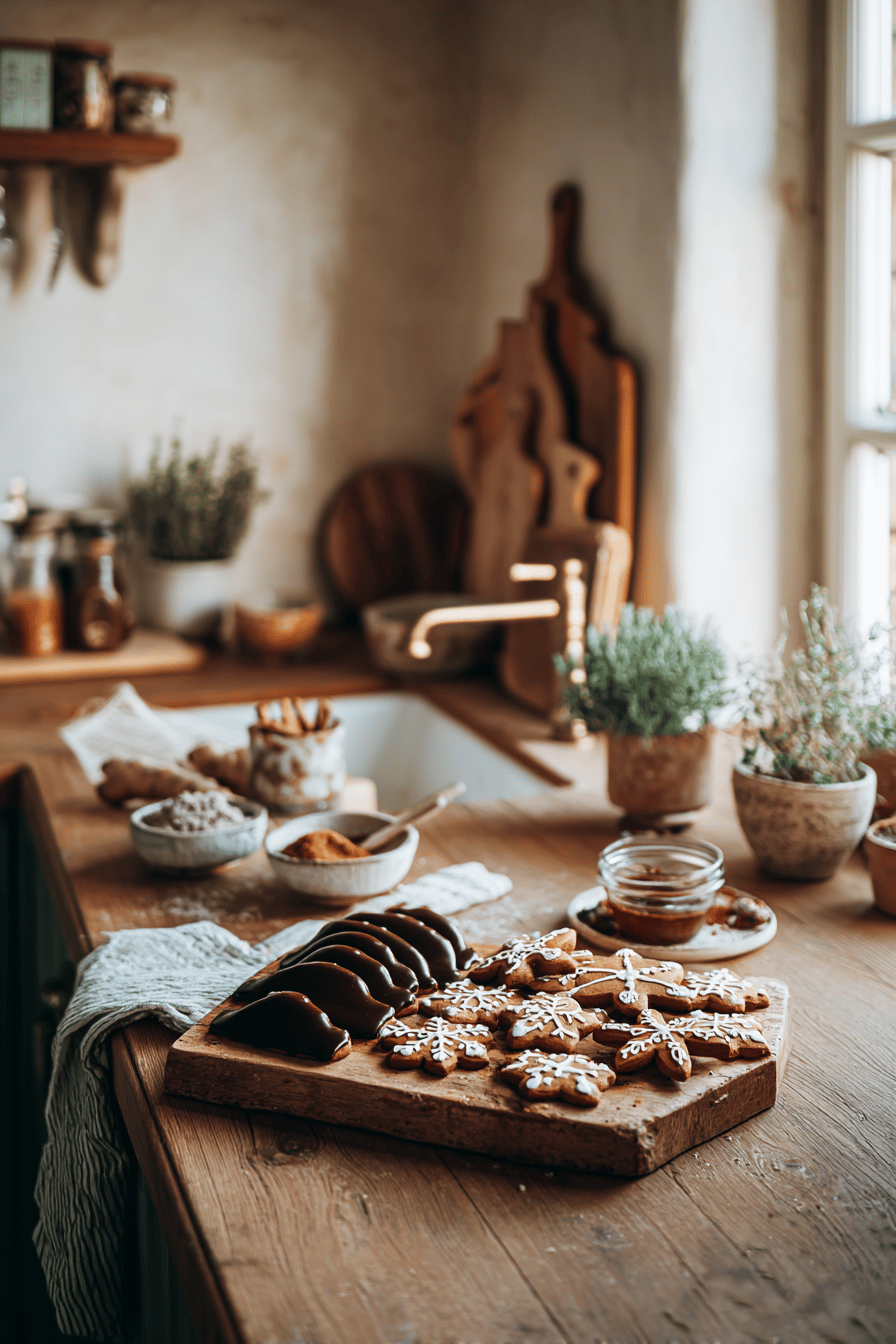
Advanced Tips and Variations
Enhancing your gingerbread cookies can be as simple as fine-tuning spices or presenting them in new forms. Below are techniques and variations that help customize your baking experience and palate.
Spice and Flavor Enhancements
- Use freshly ground cinnamon, ginger, and cloves for more vibrant and aromatic cookies.
- Add a pinch of black pepper or cardamom to the spice blend to introduce subtle warm layers.
- Swapping dark molasses for lighter molasses or blending with maple syrup or honey can soften the flavor profile and add complexity.
Creative Presentation Ideas
- Decorate with royal icing or sprinkle crystallized sugar for festive appeal.
- Dip half of the cookies in melted dark chocolate for a rich contrast.
- Try gingerbread cookie bars or sandwich cookies filled with spiced cream cheese for a novel serving style.
Texture and Storage Tips
- To keep cookies soft, store them with a slice of bread in an airtight container to maintain moisture balance.
- Do not overbake; for soft, chewy center cookies, remove soon after edges are set.
Experimenting with these ideas can uniquely tailor your gingerbread cookies to your taste or the occasion, ensuring fresh takes on a classic favorite.
How to Store Gingerbread Cookies: Best Practices
Proper storage is key to preserving the texture, flavor, and freshness of gingerbread cookies whether you plan to enjoy them shortly after baking or save them for later occasions.
Short-Term Storage
Store cooled gingerbread cookies in an airtight container at room temperature. To prevent cookies from sticking together, separate layers using parchment or wax paper. Under these conditions, cookies will stay fresh for up to one week.
Refrigeration
If you choose to refrigerate gingerbread cookies, use a sealed container to retain moisture and avoid absorbing odors. Refrigerated cookies can last up to two weeks but may lose some softness.
Freezing for Long-Term Storage
For extended preservation, freeze gingerbread cookies in an airtight container or zipper-lock freezer bags. Insert parchment layers between cookies to avoid sticking. Cookies stored frozen maintain their quality for up to three months.
Thawing and Serving
To enjoy frozen cookies, thaw them at room temperature or gently warm in the oven at a low temperature to refresh softness and aroma.
| Storage Method | Duration | Notes |
|---|---|---|
| Room Temperature | Up to 1 week | Use airtight container, separate cookies to avoid sticking |
| Refrigeration | Up to 2 weeks | Seal well to maintain moisture; may be less soft |
| Freezing | Up to 3 months | Use airtight containers with parchment layers; thaw before serving |
Storage knowledge supports preparing batches ahead, making gingerbread cookies a convenient choice for gatherings and gift-giving seasons.
Nutritional Value of Gingerbread Cookies
Understanding the nutritional content of gingerbread cookies can help cater to dietary goals while enjoying this seasonal treat.
| Nutrient | Per Cookie (Approximate) |
|---|---|
| Calories | 143-214 kcal (depending on sugar type and size) |
| Carbohydrates | 20-37 g |
| Protein | 1-2 g |
| Fat | 6-7 g (Saturated fat 3-4 g) |
| Cholesterol | 18-22 mg |
| Sodium | 143-158 mg |
| Potassium | 69-190 mg |
| Fiber | 0-1 g |
| Sugar | 10-24 g |
| Vitamin A | 185-210 IU |
| Calcium | 12-39 mg |
| Iron | 0.8-1 mg |
These cookies contain beneficial spices like ginger and cinnamon which provide antioxidant and anti-inflammatory properties, making them a flavorful treat with some health advantages.
Considering alternatives like vegan butter or sugar substitutes could further customize cookies for lower saturated fat or reduced sugar versions without losing the comforting essence of this recipe.
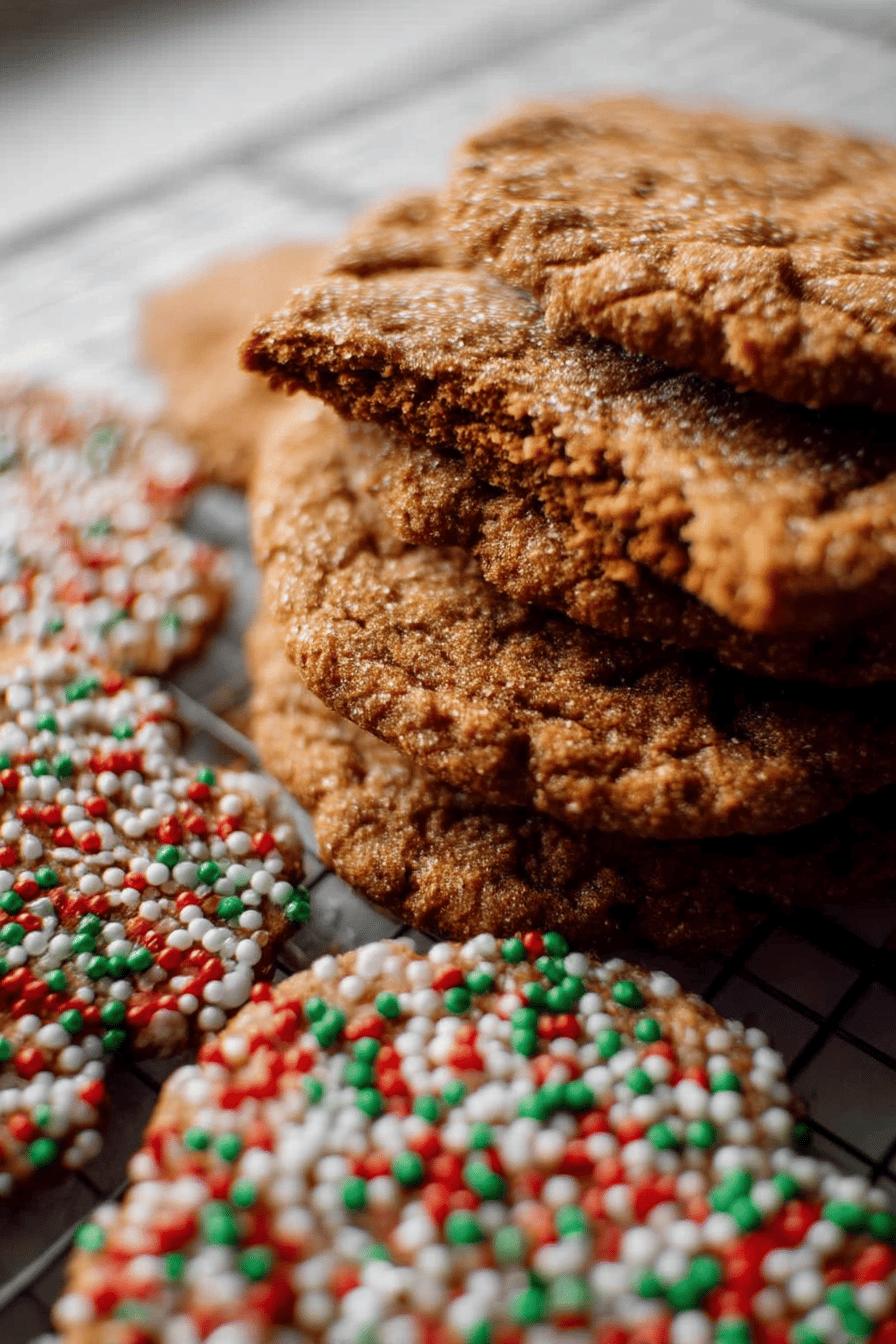
FAQs: Frequently Asked Questions About Gingerbread Cookies
What ingredients do I need to make classic gingerbread cookies?
To make classic gingerbread cookies, you’ll need brown sugar, all-purpose flour, baking soda, ground cinnamon, ground ginger, ground cloves, salt, butter, milk, and molasses. These ingredients combine to create the rich, spiced flavor and chewy texture characteristic of gingerbread cookies. This recipe is also egg-free, making it suitable for those with egg allergies.
How long should I bake gingerbread cookies and at what temperature?
Bake gingerbread cookies at 350°F (175°C) for 10 to 12 minutes. Baking for this duration ensures that the cookies are set but still soft and chewy. Avoid overbaking, as it can dry out the cookies and make them hard. Remove them from the oven when the edges start to firm up and allow them to cool completely on a wire rack.
Do I need to chill the gingerbread dough before baking?
Chilling gingerbread dough is optional. Some recipes recommend refrigerating the dough for 2 hours or overnight to make it easier to roll out and cut. However, other recipes allow you to bake immediately, making the process quicker. If you refrigerate, wrap the dough well to prevent drying and let it warm slightly before rolling.
Can I roll gingerbread cookie dough in sugar before baking?
Yes, rolling gingerbread cookie dough balls in granulated sugar before baking adds a pleasant crunch and a sparkly finish. This step is optional but can enhance both texture and appearance. Simply roll the shaped dough lightly in sugar just before placing them on the baking sheet.
Can gingerbread cookie dough or baked cookies be frozen for later use?
Absolutely. Gingerbread cookie dough can be refrigerated for 3 to 4 days or frozen for 2 to 3 months. When ready to use, thaw frozen dough in the refrigerator before rolling and baking. Baked gingerbread cookies also freeze well for up to 3 months when stored in an airtight container, retaining their flavor and texture when properly thawed.
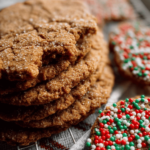
Gingerbread Cookies Recipe: Soft, Easy, and Perfect for Holiday Baking
- Total Time: 35 minutes
- Yield: 24 cookies 1x
- Diet: Vegetarian
Description
🍪 Experience the soft and chewy delight of homemade gingerbread cookies. Perfect for savoring with loved ones during the holiday season!
🎄 These easy gingerbread cookies are a fantastic treat, combining rich molasses flavors with warming spices that’s sure to please everyone.
Ingredients
¾ cup (170 g) unsalted butter, softened
1 cup (200 g) granulated sugar (can substitute with ¾ cup (150 g) packed brown sugar for richer flavor)
1 large egg
¼ cup (80 ml) unsulphured molasses (dark molasses preferred; avoid blackstrap to prevent bitterness)
2 ½ cups (312 g) all-purpose flour
2 teaspoons baking soda
½ teaspoon salt
1 to 2 teaspoons ground cinnamon
½ to 2 teaspoons ground ginger
Optional spices: ½ teaspoon ground cloves, ½ teaspoon ground allspice, nutmeg, or mace
Optional: granulated sugar for rolling cookie dough balls
Instructions
1. Preheat oven to 350°F (175°C).
2. In a large bowl, beat butter and sugar until light and fluffy, about 2-3 minutes with an electric mixer.
3. Add egg and molasses, mixing well until fully combined.
4. In a separate bowl, whisk together flour, baking soda, salt, cinnamon, ginger, and any optional spices.
5. Gradually add dry ingredients to wet ingredients and mix until a soft dough forms.
6. If desired, roll dough into balls and roll in sugar for a crunchy coating.
7. Place dough balls 2 to 3 inches apart on a baking sheet lined with parchment paper.
8. Bake for 10 to 12 minutes until edges are set but centers remain soft.
9. Cool cookies on baking sheet for 10 minutes before transferring to a wire rack.
Notes
🌟 For softer cookies, do not chill the dough. If rolling, chilling improves manageability.
🎁 Lightly flour the work surface and tools for rolled cookies to prevent sticking.
🍰 Proper measurement of flour ensures the best texture – use spooning and leveling technique.
- Prep Time: 25 minutes
- Optional chilling: 2 hours
- Cook Time: 10 minutes
- Category: Dessert
- Method: Baking
- Cuisine: American
Nutrition
- Serving Size: 1 cookie
- Calories: 143
- Sugar: 15 g
- Sodium: 150 mg
- Fat: 6 g
- Saturated Fat: 3 g
- Unsaturated Fat: 3 g
- Trans Fat: 0 g
- Carbohydrates: 25 g
- Fiber: 1 g
- Protein: 1 g
- Cholesterol: 20 mg
Keywords: gingerbread,cookies,holiday,soft

